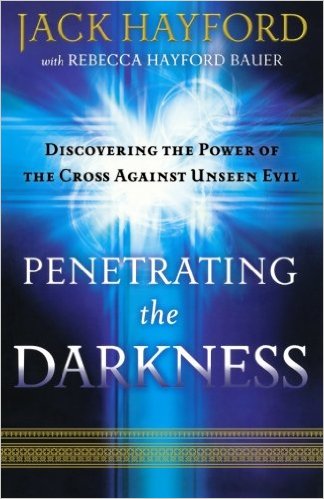Jack Hayford: Penetrating the Darkness
 Jack W. Hayford with Rebecca Hayford Bauer, Penetrating the Darkness: Discovering the Power of the Cross Against Unseen Evil (Bloomington, MN: Chosen Books, 2011), 192 pages.
Jack W. Hayford with Rebecca Hayford Bauer, Penetrating the Darkness: Discovering the Power of the Cross Against Unseen Evil (Bloomington, MN: Chosen Books, 2011), 192 pages.
Based upon the title of this book one may think that it principally discusses the demonic. While spiritual warfare is covered within its pages, this book is primarily about prayer. The author, Jack W. Hayford, believes that humanity is in the midst of a cosmic battle between the forces of good and evil, thus it is necessary for Christians to engage in prayer to overcome the darkness. Hayford emphasizes the positive impact that prayer has had upon his own life, and he desires other believers to experience its benefits as well.
The author uses scripture to argue that Christians are a part of the heavenly Kingdom, and they are called to partner with God to advance the divine will on earth. Hayford views prayer as a major component to this goal, but one cannot completely grasp God’s mission without realizing that God’s original plan has been thwarted. For Hayford, the earth is “broken” and is in need of repair. He maintains that God’s Kingdom will be restored in the future, and Christians should do what they can, largely through prayer, to bring about divine purposes now. Hayford is clear to reject a realized eschatology, or an eschatology that is dependent upon human operations. God does not solely rely upon humans to accomplish his will, but Christians, as a result of their regeneration, should want to partner with God. Hayford considers human participation, including prayer, an “invitation” from God.
Hayford reviews what he calls the basics of prayer. First, it should be a daily activity. He says that time needs to be set aside, but the amount of time is not important, as that can vary from person to person; however he does recommend the morning. The author also argues that there are different types of prayers, such as prayers of thanksgiving and praise, prayers for cleansing, and prayers for power and anointing. He recognizes that there are many types of prayer, and God may call upon us to offer various kinds at different times. Yet Hayford’s primary goal is to introduce the fundamentals of this spiritual discipline.
Intercession is also a large focus for Hayford. He argues that prayer is not something reserved exclusively for personal development, but believers are to pray for others. Through intercession Christians battle demonic forces, and with the help of the Holy Spirit they expand the reaches of the kingdom of God. Hayford expresses his desire for more believers to engage in this practice. In doing so, the current direction of negative situations can be reversed.
Hayford’s atonement theory strongly influences his theology of prayer. He writes, “In every circumstance we face in life we now have the legal right, through the blood of Jesus Christ, to enter a plea and to lay claim to the evidence – His slain body, His shed blood at the cross” (89). According to Hayford, prayer brings liberty; it frees us from reaping the sins of our past.
It is clear that this book was written for a popular audience and not intended for academics. Hayford emphasizes many of his points by providing personal experiences and anecdotal stories. Consequently, his text is a very practical and readable approach to prayer, so it can benefit Christian in all stages of life. But it may be of particular encouragement to those who hope to deepen a fledgling prayer life. Throughout his book Hayford presents a very conservative Evangelical theology that is consistent with what I would expect from him, based upon his prior publications. Some may critique that Hayford advocates, or in the very least comes close to, a name-it-claim it theology, especially his view of the atonement. Despite this, Hayford acknowledges that sometimes prayer takes time, and it may bring turmoil as one “travails” through times of unanswered prayer. He argues that the end may not always be in sight, but we must continue to push forward, trusting in God. While the book is very optimistic about prayer, my concern is that neglects to wrestle with deeper theological questions related to unanswered prayer and theodicy. Many readers are likely to embrace it as an encouraging and uplifting book that contains many practical tips to developing a more consistent prayer life.
Reviewed by David Bradnick
Category: Living the Faith, Winter 2016


